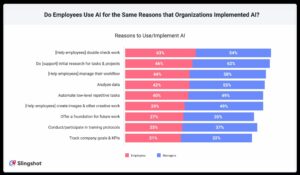Slingshot has published Part 1 of its two-part 2024 Digital Work Trends Report. The second annual report highlights a gap between managerial expectations for AI in the workplace and how employees are actually using it in their daily tasks. While employers have integrated AI to assist with initial research for tasks and projects (62%), manage workflow (58%), and analyze data (55%), nearly two-thirds of employees (63%) are mainly using AI to double-check their work.
The new 2024 Digital Work Trends report, based on research conducted by market research firm Dynata, on behalf of Slingshot, reveals that only 23% of employees feel completely educated and trained on AI. And while 72% of employers say their employees are at least adequately trained on AI, only 53% of employees believe they are. There’s also a significant difference between genders with AI training: two-thirds (66%) of males feel they are adequately trained on AI, while only 44% of females say the same.
Additional findings of the report include:
- Employers believe AI is driving more productivity than employees are experiencing: While more than half (60%) of employers believe that AI is significantly increasing employees’ productivity, only 44% of employees say they’re seeing a significant increase to their productivity with AI. Ten percent (10%) of employees say that AI is not increasing their productivity at all.
- A majority of employees are getting at least one to two hours back in their workday with AI. Seventy-nine percent (79%) of employees say that AI saves them at least 1-2 hours a day, with 37% of employees saving 3-4 hours using AI tools. With the extra time in their workday, 63% of employees are reducing their overload of work to complete tasks in a timely manner, and 54% are using the time saved to re-prioritize and manage their workload more efficiently.
- Many employers say their company’s data is not ready to support AI. Nearly half (45%) of employers say they haven’t yet implemented AI because their company’s data—or information that tracks performance, process, people and profitability–is not ready. For many companies, this means their data is siloed across departments, platforms and channels, and without centralized data, AI cannot run. Data is top of mind for employees too: 32% of employees say their company would be ready to support AI if it offered more training around data and AI.
“The workplace continues to undergo a rapid transformation as we now see more employers implementing AI tools into their businesses to drive efficiencies and increase productivity. While employers have specific intentions for AI in the workplace, it’s clear that they’re not aligned with employees’ current use of AI. Much of this comes down to employees’ education and training around AI tools,” said Dean Guida, Founder of Slingshot.
“AI has the potential to change the way teams work by allowing them to trade in highly repetitive, mundane tasks for more high-level, strategic projects. But the only way to unlock AI’s full potential in the workplace is to properly prepare employees and companies’ overall operations. Employers and employees are certainly on their way, but there’s still a lot more to be done, starting with centralizing data, increasing education around AI and reskilling and upskilling employees through continued training,” continued Guida.

Slingshot’s research is based on responses from 253 adult respondents across four age groups and all 50 states. Part 1 of the 2024 Digital Work Trends Report can be viewed here.
Related News:
Digital Work Trends Report Findings Released by Slingshot
Top Software Development Challenges in 2024 Will be AI Integration

